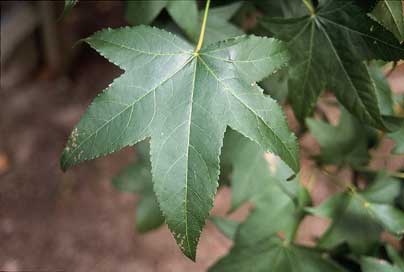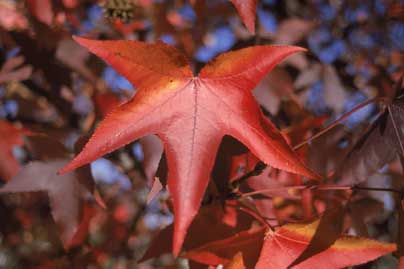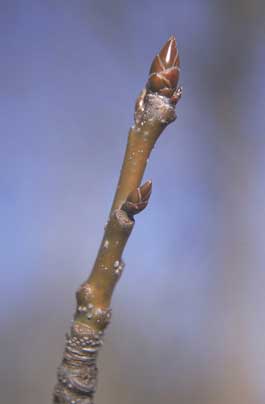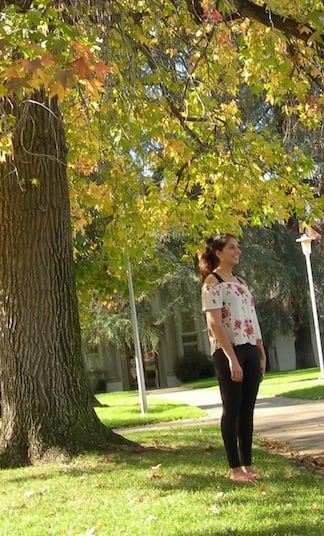University of Redlands Emergency Alert System
Alert Received: . For more information, visit: https://www.redlands.edu/alert/
University of Redlands
Common Name: American Sweetgum
Scientific Name: Liquidambar styraciflua
Family: Altingiaceae
Identification
Habit: The shape of the canopy of the sweetgum tree is a pyramid and as the tree ages, it becomes more oval shaped. At maturity, the tree can grow up to about 70 feet (20 m) tall and the width of the tree’s trunk can be up to about 40 inches (1 m).
 Here is a picture of a mature sweetgum tree in the spring, from https://selectree.calpoly.edu/tree-detail/liquidambar-styraciflua.
Here is a picture of a mature sweetgum tree in the spring, from https://selectree.calpoly.edu/tree-detail/liquidambar-styraciflua.
Leaves: The sweetgum typically has large leaves with five pointed lobes and the edges of the leaves are toothed. This leaf shape resembles a star. During the fall, the leaves change colors from a deep green to many different shades of orange, brown, and red.

 The photos above from http://forestry.ohiodnr.gov/sweetgum depict different leaf colors of the sweetgum (summer above, winter below).
The photos above from http://forestry.ohiodnr.gov/sweetgum depict different leaf colors of the sweetgum (summer above, winter below).
Twigs and bark: The twigs are yellowish brown with big shiny buds at the tips. The light gray and brown bark of the sweet gum is rough in texture with slight ridges going throughout the entire trunk. The branches and twigs of this plant hang downward and droop towards the ground, however they are strong enough to resist breakage.

 Here is an up-close photo of a sweetgum twig from http://forestry.ohiodnr.gov/sweetgum and the bark of the sweetgum from https://selectree.calpoly.edu/tree-detail/liquidambar-styraciflua.
Here is an up-close photo of a sweetgum twig from http://forestry.ohiodnr.gov/sweetgum and the bark of the sweetgum from https://selectree.calpoly.edu/tree-detail/liquidambar-styraciflua.
Flowers and fruit: The flowers on the sweetgum grow near the top of the tree and can be difficult to see. The flowers are in an inflorescence meaning that they are clustered together. These clusters are composed of male and female heads. The unique arrangement of these flowers assists in fertilization. The male and female heads are very sensitive to cold and are easily damaged by frost.
The fruit is found dangling underneath the branches. During the summer, the soft tissue of the fruit dries up and turns into a prickly shell that protect the seeds. This dry fruit splits open to release the seeds stored inside.

The photo above shows cluster of male flowers above the leaves and female flowers below the leaves, from https://bwwellsassociation.wordpress.com/2016/04/07/spring-flowers-of-the-sweet-gum-tree-liquidambar-styraciflua/.
 The seeds of this plant are contained in a dry fruit, as shown above, from http://bobklips.com/treeflowers6.html.
The seeds of this plant are contained in a dry fruit, as shown above, from http://bobklips.com/treeflowers6.html.
Where It’s From
Native Range: The sweetgum is native to Mexico, Guatemala, Central America and eastern USA. These regions typically have short to medium winters with no to medium frost periods.
Ecological Notes: The sweetgum’s flowers produce large quantities of pollen and are wind pollinated. This plant thrives when it is exposed to lots of sunlight and minimal shade. The sweetgum tree can grow in most soils but prefers slightly acid, moist soil. It has the ability to regrow from a stump even after it has been cut down. The roots of this tree are shallow and have been known to ruin sidewalks. Sweetgum is susceptible to caterpillars, leaf miners, webworm, and canker. Grazing mammals such as goats or rabbits can cause severe damage to young seedlings.
What we use it for
The wood from the sweetgum can be used for lumber, plywood, veneer and fuel. Boxes, furniture, baskets, and interior woodwork can be made from it. In landscaping, the sweetgum is primarily used to create shade.
The resin (storax) found within the sweetgum possesses many health benefits. The storax and the essential oils obtained from the tree are what hold the medicinal properties. The essential oils can be extracted from the leaves and used for their antimicrobial properties to help heal viruses or bacterial infections. The storax has even more uses and is made by boiling resin in water. The resin is stored in the inner layer of bark and can be extracted by damaging the outer layer of epidermis on the tree. Once the storax is obtained it can be used for its antibacterial properties, to make soap, perfumes, or to make adhesives.
References
Biographer
Niki Kruk ’21, FYS 20: Plants in Our World, Fall 2017
